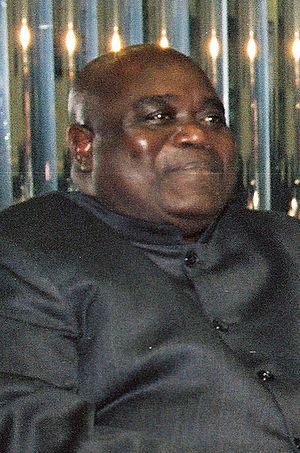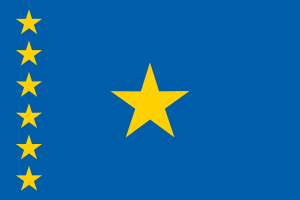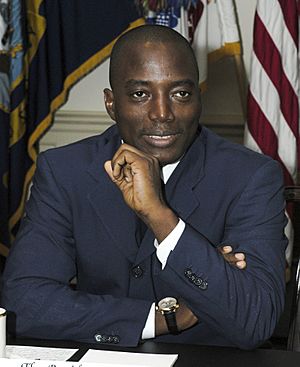Laurent-Désiré Kabila facts for kids
Quick facts for kids
Laurent-Désiré Kabila
|
|
|---|---|

Kabila in 1998
|
|
| 3rd President of the Democratic Republic of the Congo | |
| In office 17 May 1997 – 16 January 2001 |
|
| Preceded by | Mobutu Sese Seko (as President of Zaire) |
| Succeeded by | Joseph Kabila |
| Personal details | |
| Born | 27 November 1939 Baudouinville or Jadotville, Belgian Congo |
| Died | 18 January 2001 (aged 61) Kinshasa, Democratic Republic of the Congo |
| Cause of death | Assassination |
| Nationality | Congolese |
| Political party | People's Revolution Party (1967–1996) Alliance of Democratic Forces for the Liberation of Congo (1996–1997) Independent (1997–2001) |
| Spouse | Sifa Mahanya |
| Children | at least 9 or 10 (including Joseph Kabila, Jaynet Kabila, Zoé Kabila and Aimée Kabila Mulengela) |
| Alma mater | University of Dar es Salaam |
| Profession | Rebel leader, President |
| Military service | |
| Allegiance | |
| Battles/wars |
|
Laurent-Désiré Kabila (born 27 November 1939 – died 18 January 2001) was a Congolese revolutionary and politician. He became the third President of the Democratic Republic of the Congo in 1997. He served as president until he was killed in 2001.
Kabila was a long-time opponent of Mobutu Sese Seko, who was the leader of Zaire (now the Democratic Republic of the Congo). Kabila led a rebel group called the Alliance of Democratic Forces for the Liberation of Congo (ADFLC). This group was supported by Rwanda and Uganda. They invaded Zaire and removed Mobutu from power during the First Congo War (1996–1997).
After becoming president, Kabila changed the country's name back to the Democratic Republic of the Congo. He then asked all foreign troops to leave the country. This led to the Second Congo War, where his former allies, Rwanda and Uganda, started supporting new rebel groups against him. Kabila was killed by one of his bodyguards during this war. His son, Joseph Kabila, became president ten days later.
Contents
Early Life
Laurent-Désiré Kabila was born in the Belgian Congo. His birth took place in either Baudouinville (now Moba) or Jadotville (now Likasi). His father was from the Luba people, and his mother was from the Lunda people.
Political Activities
Congo Crisis
After Congo became independent in 1960, a region called Katanga tried to break away. Kabila helped organize people from the Baluba group to fight against this separation. He became a member of the local assembly and worked for the Minister of Information. Later, he was asked to resign because of ideas that were seen as communist.
Kabila supported other leaders who wanted to follow the ideas of Patrice Lumumba, an important early leader of Congo. When a group called the National Liberation Council was formed, Kabila went to eastern Congo. His job was to help start a revolution there. This was part of the bigger Simba rebellions happening at that time. In 1965, Kabila set up a rebel operation from Tanzania, across Lake Tanganyika.
Meeting Che Guevara
Kabila met Che Guevara, a famous revolutionary, in April 1965. Guevara came to Congo with about 100 Cuban fighters. They hoped to start a revolution similar to the one in Cuba. Guevara helped Kabila's rebel forces for a few months. However, Guevara felt that Kabila was not serious enough about the revolution. He thought Kabila was often distracted and that his fighters were not well-trained.
Guevara also noted that Kabila sometimes arrived days late with supplies. This lack of teamwork between Kabila and Guevara contributed to the rebellion failing later that year.
Rebel State (1967–1988)
In 1967, Kabila and his remaining supporters moved to a mountainous area in South Kivu. There, they started a group called the People's Revolutionary Party (PRP). With help from China, the PRP created its own small state in South Kivu province. This state followed Marxist ideas.
The PRP state ended in 1988, and Kabila disappeared for a while. Many people thought he had died. During this time, Kabila reportedly met Yoweri Museveni, who would later become the president of Uganda. Museveni and former Tanzanian President Julius Nyerere later introduced Kabila to Paul Kagame, who would become the president of Rwanda. These connections became very important in the mid-1990s. Uganda and Rwanda needed a Congolese leader to support their actions in Zaire.
First Congo War
After the 1994 genocide in Rwanda, many Rwandan Hutu refugees fled to Congo (then called Zaire). Some of these refugee camps near the Zaire-Rwanda border became home to Hutu militias. These militias wanted to take back power in Rwanda. Rwanda saw these militias as a threat to their safety. They asked Zaire to move the refugee camps further away, but Zaire did not.
Rwanda then decided that military action was needed. To avoid looking like an invasion, they helped start a rebellion. This is how the Alliance of Democratic Forces for the Liberation of Congo (AFDL) was formed, with Kabila as its spokesperson.
By mid-1997, the AFDL had taken over almost all of the country. Mobutu's army was defeated. The poor roads and infrastructure in Congo were the only things that slowed Kabila's forces down. After peace talks failed, Mobutu fled the country on 16 May.
The next day, Kabila announced his victory from his base in Lubumbashi. He became the new president. Kabila suspended the country's Constitution. He also changed the country's name from Zaire back to the Democratic Republic of the Congo. He arrived in Kinshasa on 20 May and officially became president on 31 May.
Presidency (1997–2001)

Kabila had been a Marxist, but his policies as president were more like social democracy. He said that elections would not happen for two years. He felt he needed that much time to bring order back to the country. Some people in the West saw Kabila as a new kind of African leader. However, others criticized him. They said his leadership was similar to Mobutu's. They pointed to issues like strict control and unfair treatment of people. By late 1997, some people were calling Kabila "another Mobutu."
By 1998, Kabila's former allies, Uganda and Rwanda, turned against him. They supported a new rebellion by the Rally for Congolese Democracy (RCD). This started the Second Congo War. Kabila found new allies in Angola, Namibia, and Zimbabwe. With their help, he managed to keep control of the southern and western parts of the country. By July 1999, peace talks led to most foreign forces leaving.
Assassination

Laurent-Désiré Kabila was shot in his office on 16 January 2001. He was taken to Zimbabwe for medical care.
The government of the Democratic Republic of Congo managed to stay in power after Kabila's death. The exact details of his death are still debated. Some reports say he died right away after being shot. However, the government said he was still alive and flew him to a hospital in Zimbabwe. This allowed them time to organize who would take over as president.
The Congolese government announced that he had died from his injuries on 18 January. One week later, his body was brought back to Congo for a state funeral. His son, Joseph Kabila, became president ten days later. Officials said that Kabila had told them his son Joseph should take over if he died in office.
An investigation into Kabila's assassination took place. In January 2003, some people were found guilty and sentenced to death, but they were not executed. Many others were jailed. In January 2021, the current President, Félix Tshisekedi, pardoned those who had been convicted in Kabila's murder. They were then released from prison.
Personal Life
Laurent-Désiré Kabila had at least nine children with his wife, Sifa Mahanya. Their children include Josephine, Cécile, Fifi, Selemani, twins Jaynet and Joseph, Zoé, Anina, and Tetia. He was also said to be the father of Aimée Kabila Mulengela.
See also
 In Spanish: Laurent-Désiré Kabila para niños
In Spanish: Laurent-Désiré Kabila para niños

